Regular maintenance of resin-bound gravel in busy areas requires a stiff-bristled broom for daily sweeping to clear leaves and rubbish. Give the surface a gentle rinse with a garden hose, and tackle any tea or coffee spills with warm, soapy water and a soft brush – much like cleaning your patio. Skip harsh cleaning products, as they’ll damage the surface.
Once monthly, use a pressure washer on its lowest setting (think gentle rain rather than jet spray). Keep an eye out for any unwanted plants poking through and pull them straight away. Each season, check for small cracks – particularly after winter – and top up the sealant where needed. These simple steps keep the surface safe and smart-looking whilst protecting your investment.
Key Takeaways
Clean high-traffic resin-bound gravel areas:
- Give it a proper sweep daily with a stiff-bristled broom to shift loose bits and keep it safe for foot traffic.
- Once a week, give it a gentle wash with your garden hose – no need for full blast, just enough to keep it clean and stop any moss taking hold.
- Every month, use a pressure washer on low power to tackle stubborn marks and keep the surface grippy (think gentle rain, not jet wash).
- Keep your eyes peeled for any cracks appearing and top up the sealant when needed – it’s like giving your driveway a raincoat.
- Spot any weeds poking through? Simply pull them out by hand, especially around the edges where they love to sprout.
Importance of Regular Cleaning in High-Traffic Areas
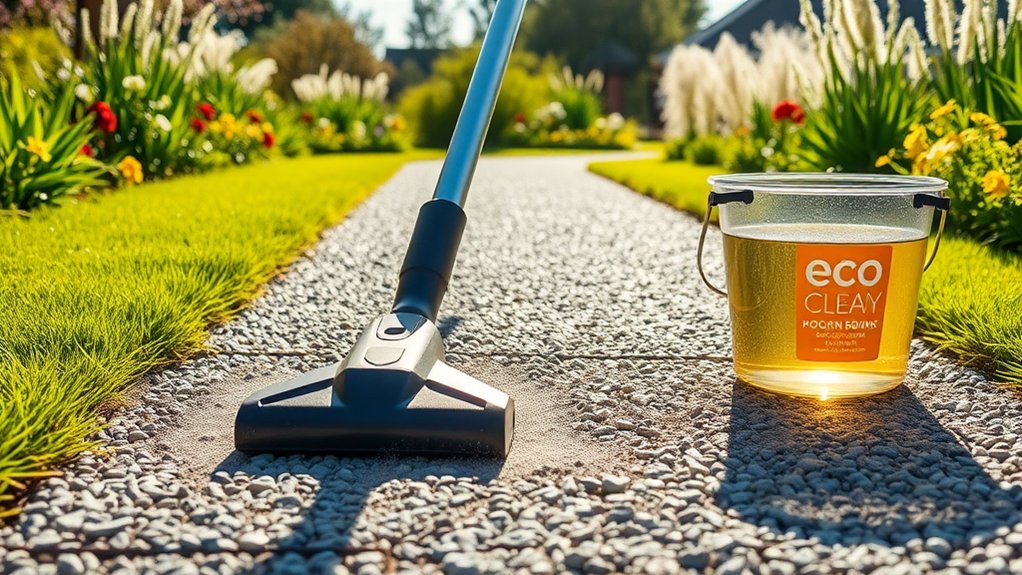
Regular cleaning of high-traffic gravel areas is essential for safety and longevity. Proper maintenance reduces slip risks, particularly during Britain’s wet weather, by keeping the surface’s grip intact. A neglected surface can lead to surface damage from dirt accumulation, which can compromise both safety and aesthetics.
Clean gravel drains better, much like a well-maintained garden path, preventing puddles and helping rainwater soak into the ground naturally. This is especially important because the porous nature of resin-bound gravel allows for rainwater drainage, reducing flooding risks.
Regular upkeep stops oil and grime from building up, which is particularly important in car parks and busy walkways. Think of it like sweeping your patio – little and often keeps it looking smart and working properly.
Without proper cleaning, gravel surfaces can become compacted and lose their effectiveness, rather like a blocked drain. The result? A longer-lasting surface that’s safer, looks better, and meets safety standards – whilst saving money on costly repairs down the line.
Recommended Cleaning Techniques for Resin-Bound Surfaces
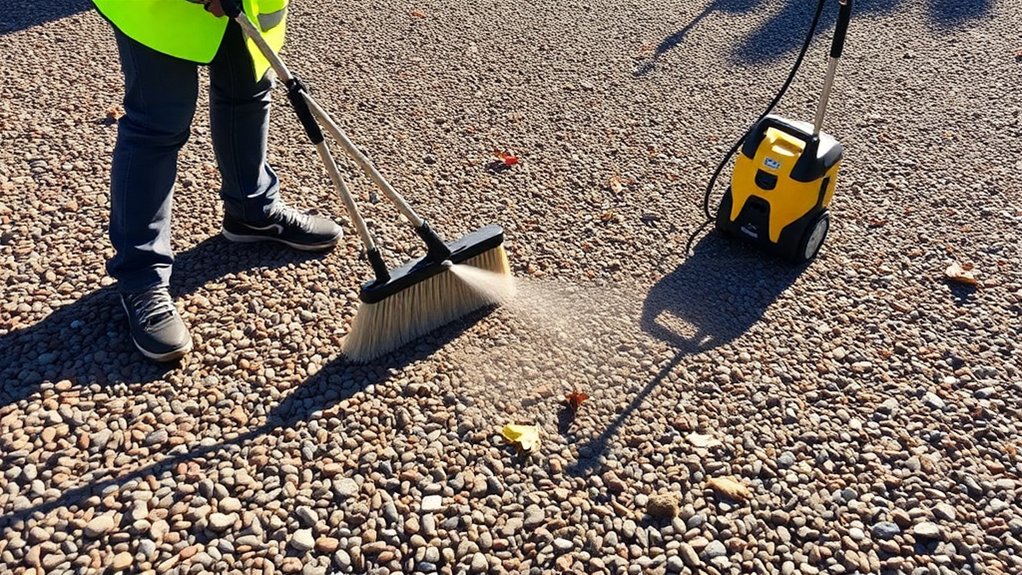
Regular, gentle cleaning keeps resin-bound surfaces in top condition. Deal with any spills or stains straight away using warm, soapy water and a soft brush. For tougher marks like oil or wine, specialist resin cleaners from your local DIY shop work best. A monthly pressure wash on a low setting helps maintain the surface’s grip and appearance – much like giving your car a proper wash. Avoid harsh chemicals or metal scrapers, as these can scratch or damage the finish. Regular cleaning is necessary to maintain the surface quality of resin-bound areas, as it helps prevent moss and algae buildup which can compromise drainage functionality.
Gentle Cleaning Methods
Gentle cleaning keeps resin-bound surfaces in top shape.
Start with a good sweep using a stiff broom to shift loose bits and stop moss taking hold.
Once that’s done, check for any stubborn marks. A garden hose on low pressure works well for washing – just keep the nozzle at least 20cm away to avoid any damage.
A Whirlaway cleaner does a brilliant job of shifting dirt without being too harsh.
For tougher spots, warm water with a dash of washing-up liquid should do the trick. Regularly conducting regular inspections can significantly help in maintaining the surface’s integrity.
Choose your cleaning tools carefully, and avoid cleaning during freezing weather or intense heat.
Regular inspections for early detection of issues can also help maintain the surface’s integrity.
Pop these simple jobs into your regular garden routine, and your resin surface will stay looking fresh for years to come.
Stain Management Tips
Managing Stains on Resin Surfaces
Tackle fresh oil spills straight away using absorbent materials like cat litter or bicarbonate of soda.
For oil marks, apply a suitable outdoor degreaser or mix washing-up liquid with warm water, then gently scrub with a soft brush. Follow with a thorough rinse.
Tyre marks need warm, soapy water and careful scrubbing.
For tough mineral stains, oxalic acid works well – but test it first on a discrete spot. Be careful with acid cleaners, as they can damage the resin if left too long.
Best to stick to environmentally friendly cleaning products to protect both your resin surface and local wildlife.
A quick response to spills makes all the difference to the end result.
Regular Maintenance Practices
Regular maintenance keeps resin-bound surfaces in top condition, particularly in busy areas. A proper care routine includes daily, weekly and seasonal tasks to ensure lasting durability.
| Maintenance Type | Recommended Actions |
|---|---|
| Daily | Sweep thoroughly with a stiff brush to clear debris |
| Weekly | Wash down with a hosepipe; check for leftover debris |
| Seasonal | Check for cracks; apply protective sealant |
Regular upkeep helps maintain a tidy appearance whilst reducing the need for intensive cleaning. Spotting and fixing problems early prevents serious damage to your resin-bound surface.
Preventing Damage During the Cleaning Process
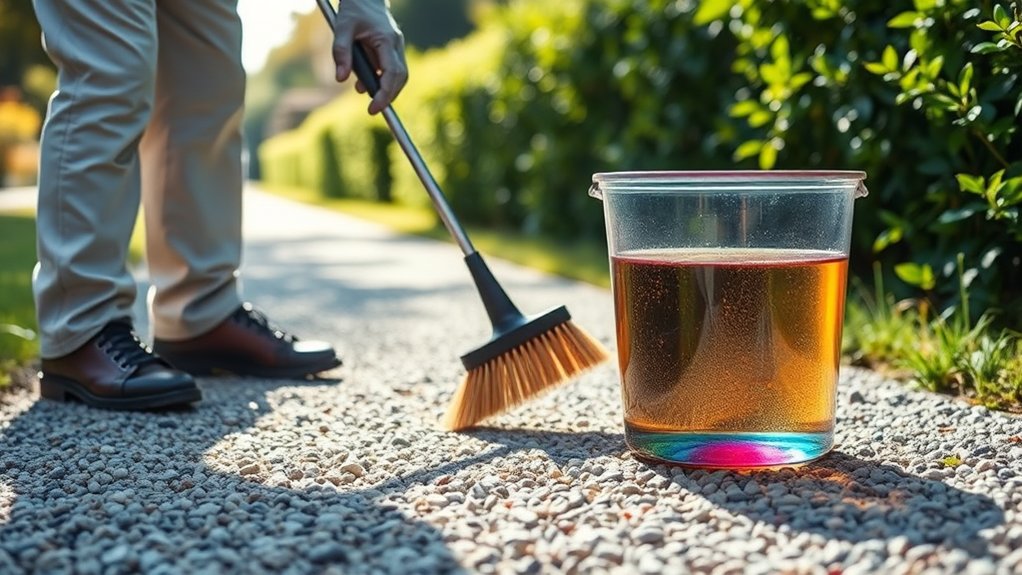
Clean gravel areas with care to protect the resin surface from damage. Use a stiff-bristled broom to remove loose debris, and avoid harsh cleaning products that might harm the resin.
Check regularly for signs of wear – much like you’d keep an eye on your car tyres. When washing, keep water pressure below 150 bar (about the strength of a typical home pressure washer) and stay at least 20 cm away from the surface.
A quick sweep before washing makes the job more effective, just as you’d brush a carpet before deep cleaning. Deal with any stains straight away, and always use clean water to avoid spreading dirt around.
These simple steps help maintain your resin-bound surface for years to come.
Managing Weeds Effectively in Busy Spaces
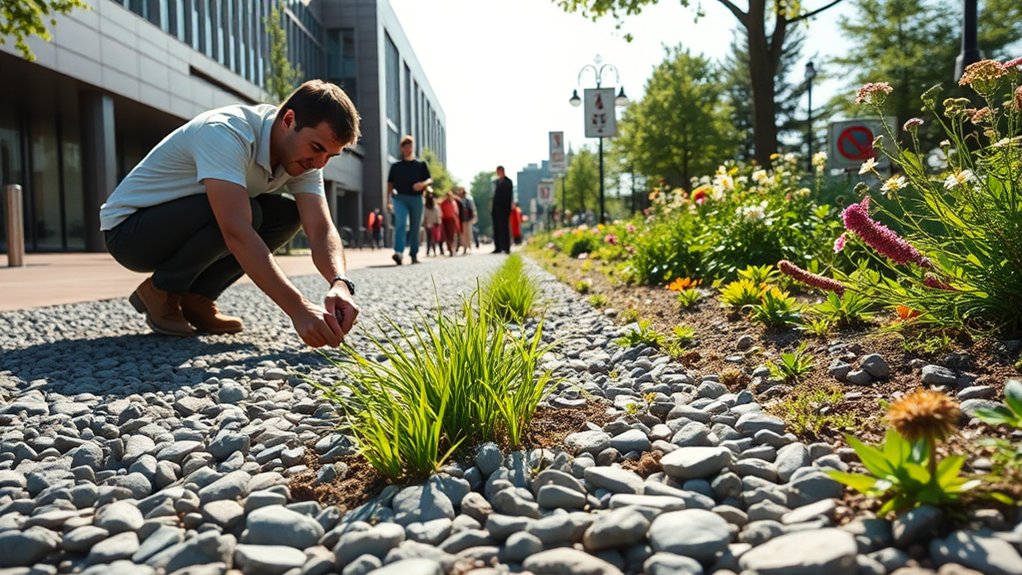
Regular checks of resin-bound areas are essential for spotting weeds before they become a nuisance.
A quick weekly walk around your driveway or garden path is enough to catch unwanted growth early on. Simply pull out any emerging weeds by hand – it’s far easier than tackling established ones and won’t harm your surface.
This straightforward approach keeps busy spaces looking smart whilst protecting your investment in the resin-bound surfacing.
Regular Inspections Importance
Regular inspections of high-traffic gravel areas help you spot and tackle weed problems early on. Check these areas frequently, particularly after windy weather when seeds often blow in.
Pay special attention to edges and corners where weeds commonly take root due to soil build-up and fallen leaves.
Quick visual checks let you sort issues before they become major headaches, saving you time and money on harsh chemical treatments that might damage your resin surface.
By staying on top of inspections, you’ll keep your resin-bound surface looking smart and lasting longer – much like checking your car’s oil regularly prevents engine problems.
Best practice is to scan the area whilst walking across it, looking for any tiny green shoots poking through.
It’s far easier to pull out a few seedlings than to deal with established weeds that have properly taken hold.
Hand Weeding Techniques
Regular checks help spot the best times for hand weeding, particularly in busy areas where weeds can quickly take hold.
Pull weeds firmly from their base, making sure to remove the entire root system – much like pulling out a stubborn carrot from your veg patch. A good narrow fork or hand trowel works brilliantly for lifting weeds without making a mess of your gravel surface.
Keep an eye out during weekly garden checks to catch any new weeds whilst they’re small. For tough weeds like dandelions or dock, use both hands and tools together to get right down to those deep roots.
Give your tools a quick clean after use to keep them working properly. These simple methods will keep your gravel areas looking smart whilst keeping weeds at bay.
Seasonal Maintenance Tips for High-Traffic Areas
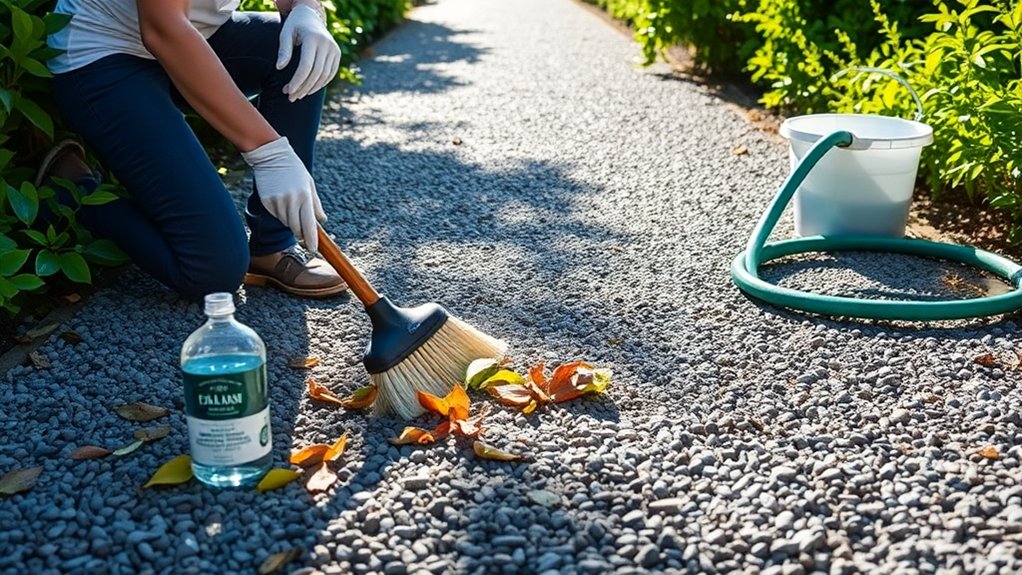
Seasonal Maintenance Tips for High-Traffic Areas
Proper maintenance of high-traffic gravel areas is vital for British weather conditions, from wet winters to unpredictable summers. A few key practices keep these spaces safe and looking smart year-round.
- Regular sweeping removes fallen leaves, twigs and general rubbish that collects daily.
- Winter damage checks help spot frost damage and surface wear, particularly after harsh weather.
- Weed control stops unwanted growth between stones, common in damp UK conditions.
- Snow clearance with plastic tools prevents surface damage (avoid metal shovels).
- Drainage inspection ensures water flows properly, especially crucial during autumn downpours.
Protective Measures to Extend Surface Lifespan
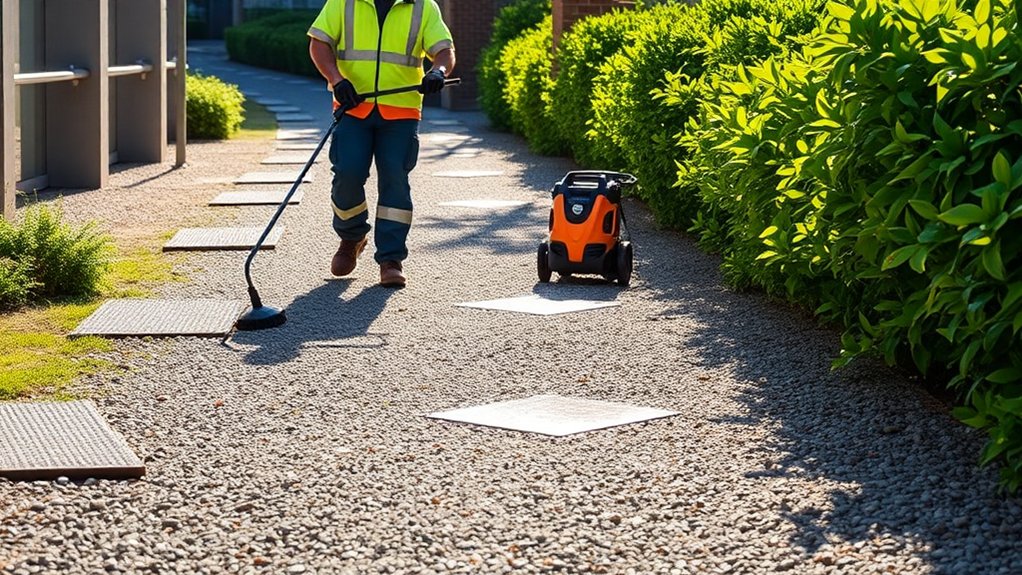
Extending High-Traffic Gravel Surface Life
Proper materials and installation methods are essential for long-lasting gravel surfaces. The right resin flexibility and aggregate choices significantly boost durability. Key protective measures include:
| Measure | Description | Benefit |
|---|---|---|
| Material Selection | UV-stable resins (like those used in motorway surfaces) | Prevents colour fade |
| Installation Technique | Precise resin-to-aggregate mix | Ensures lasting strength |
| Edge Protection | Secure perimeter installation | Stops gravel wash-away |
| Thickness Consideration | 18mm minimum for driveways (about two pound coins stacked) | Boosts overall strength |
| Slip Resistance | Crushed glass blend in resin | Better grip in wet conditions |
The investment in quality materials and proper installation typically saves money long-term, avoiding frequent repairs common with cheaper alternatives.
Frequently Asked Questions
How Often Should I Inspect High-Traffic Resin-Bound Surfaces?
Inspect high-traffic resin-bound surfaces daily for obvious damage, sweep through weekly to clear debris, and carry out thorough monthly checks. Much like checking your car’s tyres, these regular inspections help catch problems early and keep the surface in top condition for years to come.
Can I Use a Pressure Washer on Higher Settings?
Higher pressure washer settings might seem appealing, but they’re best avoided. Stick to manufacturer-recommended levels, as excessive pressure can damage brickwork, strip paint or crack wooden decking. For most home jobs, a medium setting works brilliantly – strong enough to shift grime from your patio or driveway, yet gentle enough to preserve surfaces. If you’re cleaning your car, drop the pressure even lower to protect the paintwork.
What Are the Signs of Wear in Resin-Bound Areas?
Common wear signs in resin-bound surfaces include cracks, potholes and fading from sunlight or spillages. A regular check of your driveway or patio can spot these issues before they worsen – much like checking your car’s tyres for wear. Keep an eye out for patches that look dull or feel loose underfoot, particularly after harsh weather.
Are There Specific Products for Oil Stain Removal?
Specialised cleaning solutions effectively remove most oil stains from resin surfaces. These cleaners are widely available in UK DIY shops and work by breaking down oils whilst protecting the resin beneath – much like how washing-up liquid tackles greasy dishes. For best results, look for products specifically labelled for resin or concrete oil removal.
How Do I Prevent Damage From Heavy Vehicle Traffic?
Prevent heavy vehicle damage by limiting access to designated routes, installing reinforced concrete or specialised tarmac surfaces, and scheduling lorry movements for dry weather. Check vehicle weights against surface limits and choose proper materials – like industrial-grade paving – to ensure long-term durability. Common examples include delivery yards and building sites, where proper surfacing can mean the difference between a stable ground and costly repairs.
Conclusion
Regular cleaning of high-traffic resin-bound gravel surfaces is essential to maintain their appearance and durability. Without proper maintenance, these areas can quickly become unsightly and potentially damaged. A well-planned cleaning routine, combined with seasonal upkeep, helps protect your investment and keeps the surface looking smart year-round – much like maintaining a garden path or driveway.
